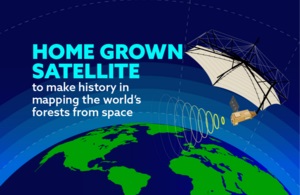UK and Sweden join the LOFAR ERIC

Above: LOFAR array at STFC Chilbolton site.
Courtesy UKRI / STFC / Credit: Guy Gratton
LOFAR is the world’s largest and most sensitive radio telescope operating at low frequencies (10 to 240 megahertz).
Unlike single-dish telescopes, LOFAR is a multipurpose sensor network with an innovative computer and network infrastructure that can handle extremely large data volumes.
The revolutionary multibeaming capabilities of the LOFAR telescope allow astronomers to engage in multiple lines of research simultaneously.
Scientists can look back billions of years to a time before the first stars and galaxies formed (the so-called ‘Dark Ages’) and survey vast areas of the low-frequency radio sky.
Leading role in radio astronomy
The Science and Technology Facilities Council’s (STFC) Director of RAL Space Dr Sarah Beardsley welcomed the confirmation: "The UK’s accession to LOFAR is great news for our science community and reinforces the leading role we play in radio astronomy.
"Our Chilbolton site has been the UK hub for the LOFAR observatory for the last 15 years, and I look forward to RAL Space teams continuing to support LOFAR as the UK transitions to full membership of this fantastic research programme."
Strengthening European collaboration
This expansion brings LOFAR’s total membership to eight countries.
The infrastructure is governed by LOFAR European Research Infrastructure Consortium (ERIC), established in December 2023, as a single legal entity across the EU, with the following founding members:
- Bulgaria
- Germany
- Ireland
- Italy
- the Netherlands
- Poland
Significant milestone for the UK
STFC’s Associate Director of Astronomy, Jenny Hiscock, said: "The UK accession to the LOFAR ERIC is a significant milestone for the UK and its radio astronomy community.
"LOFAR is a flagship international science infrastructure that brings together a wealth of technology and expertise to help us probe some of the fundamental questions about the origins of the universe.
"Joining the ERIC highlights the importance of strong collaboration to deliver research and innovation, enriching lives across the globe."
Significant advancement for LOFAR ERIC
LOFAR ERIC Council Chair Jacqueline Mout expressed her enthusiasm about the expansion: "The addition of the United Kingdom and Sweden as full members represents a significant advancement for LOFAR ERIC and strengthens European collaboration in astronomy research.
"This expansion consolidates LOFAR’s position as one of the most productive radio astronomy observatories in the world.
Long-standing collaboration
Research institutes from Sweden and the UK have been collaborating with the LOFAR distributed infrastructure and research programme for around 20 years.
Onsala Space Observatory in Sweden has hosted a station of the LOFAR array since 2011, while the station at the Chilbolton Observatory in the UK was opened in 2010.
Research breakthroughs
In the last year alone, LOFAR has contributed to several astronomical research breakthroughs including:
- discovery of giant radio jets emanating from black holes
- detailed studies of galaxy clusters
- advancements in our understanding of the early Universe










